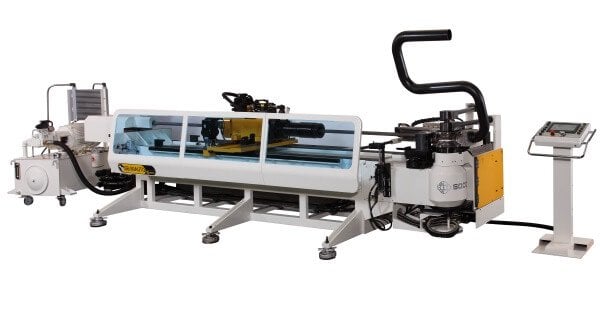As one of the most common forms of tube and pipe bending, rotary draw tube bending is used in many diverse industries for a myriad of applications. The keys to successfully using this style of bending is choosing the right rotary draw tube bender and the correct tooling for the specific application.
Rotary Draw Tube Bender Machine Options
There are many machine options available for applications where rotary draw tube bending is appropriate. It is often best to consult with a knowledgeable party about specific machine options but, in general, there are a few considerations that will help you narrow the field.

One of the things that will most impact your machine search will be the complexity of the bend you will need to make. The material you are bending and your volume of bending are also large indicators of machine style. These specifications will help you determine things like how much power a machine will need, what type of tooling you will need, or if you need a special purpose machine (very small and very large tubing sometimes require specialty machines, for instance).
Other factors that may influence your machine choice could include any end finishing you intend to do, if the machine needs to be integrated into an existing manufacturing line, or if you need to do simultaneous bending on multiple tubes.
Choosing Tooling
There are a few basic pieces of tooling you will need for any bending project. First, you will need a bend die. Bend dies are used to form the tube and determine the radius of the bend. A clamp die is also necessary to grip the tube against the bend die as the bend die rotates. The pressure die presses the tube into the bend die and applied the pressure needed to bend the tube. The wiper die supports the tube on the inside of the bend to help prevent wrinkles.
You can learn more about the most commonly used bend tooling here. In general, however, it is necessary to match the specific style, size, and material tooling to the specific application. For instance, when using a mandrel, you would typically choose a steel or chrome mandrel for bending steel, copper, aluminum, or bronze tubing but an aluminum mandrel for bending stainless, titanium, or Inconel tubing.
If you are interested in learning more about rotary draw tube benders and bending the Introduction to Rotary Draw Bending Tooling is a good place to start. This resource has lots of easy to understand diagrams and images that are accompanied by clear information, walking readers through the basics of bending tooling. Inside the guide, you fill find:
- Engineering Guidelines
- Tight Radius Bending
- Completing the Application Review
- Special Considerations & Applications
- Summary and Benefits
Click here to download the Introduction to Rotary Bending Tooling.
You May Be Interested in These Other Posts On Tube Bending:
- Extend the Life of Bending Tooling in a CNC Pipe Bender
- Tube Form Solutions Announces Release of the TFS-150 Rotary Ram Former
- No Mar Tube Bending Tooling
